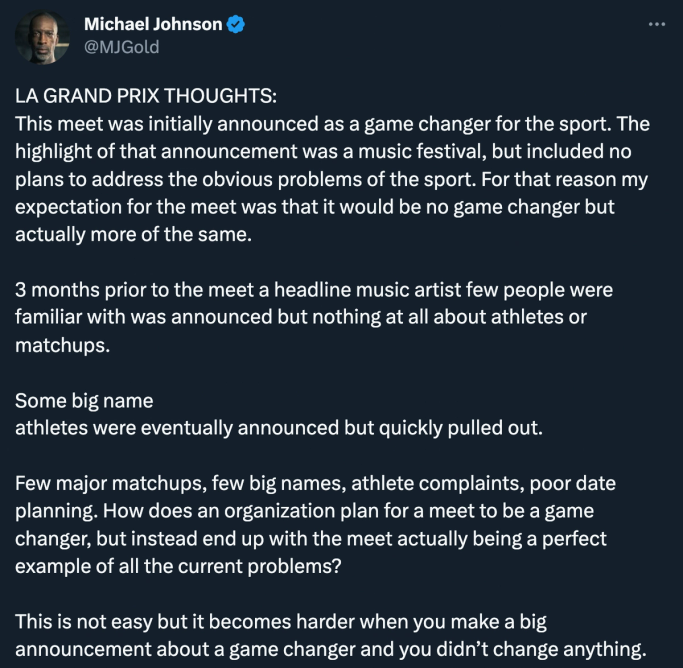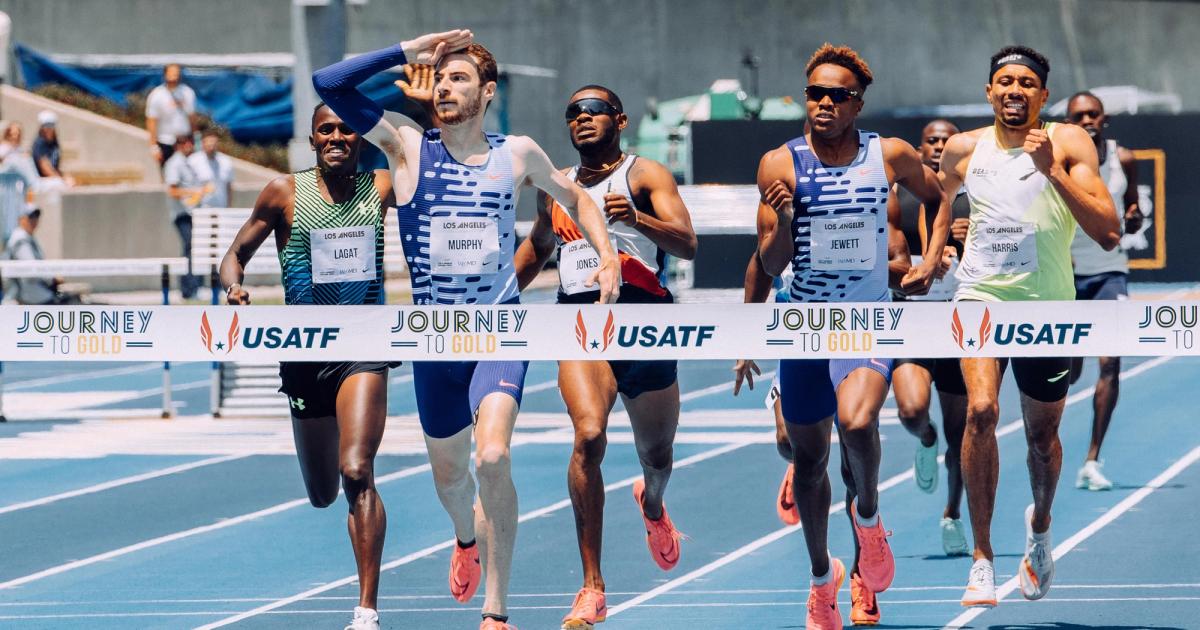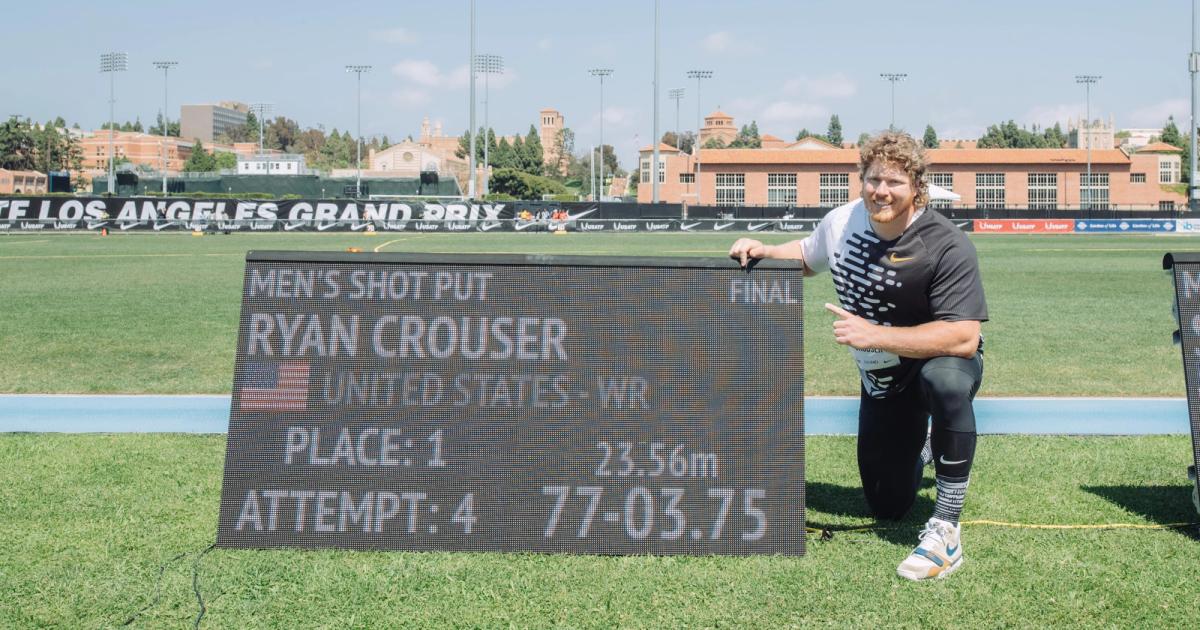By Kyle Merber
May 31, 2023
If the goal was to get track fans talking, then the USATF LA Grand Prix was certainly a success. Billed initially as “an athletics weekend unlike any other” and a “first-of-its-kind, star-studded event” that was “designed as a no-holds-barred, maximum celebration of the sport,” there was a lot of hype about what ultimately wound up being a regular track meet. (But give that copywriter a raise!)
Now, I know that probably comes across as a diss, but I promise it’s not! I love track and field and devoured the entire meet with gusto. Much to my family’s chagrin, the event had my undivided attention Friday night and Saturday afternoon! But one meet will not change the game forever, and it will not suddenly activate a gigantic – and at this point, theoretical – sleeping monolith of dormant track fans, converting them into diehards. Except for Owen Wilson. WOW!
According to the World Athletics Competition Performance Rankings, the LA Grand Prix was the most competitive meet of the year. That includes the Diamond League meets. If a single competition could sway the masses, it would have been this one! But I haven’t overheard heated track debates at the grocery store or on the train so far this week… I don’t know about you.
From a PR standpoint, this meet had its challenges. There were many high-profile athletes whose names had been used in promotion for ticket sales that never made it to the start line, or the finals: Sydney McLaughlin-Levrone, Athing Mu, Rai Benjamin, Kenny Bednarek, Aleia Hobbs, Marie-Josee Ta Lou, Erriyon Knighton, Woody Kincaid, and more.

Again, this isn’t a knock on this meet. This happens all the time, and it’s not the athletes’ fault. This is the infrastructure of the sport. To Rai’s point, even a highly-publicized meet in America’s second-largest city, the future site of the Olympics, is small potatoes compared to what’s on the line later in the season. Risking injury is not worth it physically because it is not worth it financially.
That said, given the brutal reaction Marcell Jacobs received for dropping out of the Rabat DL, maybe at some point you lose the fans if that card is pulled too often. But if WWE’s taught me anything, it’s that there’s also good money in turning heel, if there’s an interest in seeing the race.
[KYLE MERBER’S SPIN ZONE TIME: If $4,000 doesn’t move the needle for an athlete then that means they’re doing well. A lot of athletes must be getting paid well at the moment!]
One of the major challenges facing the sport is how do you promote an event knowing that top-billing stars will invariably drop out, often at the last minute? We take a page out of Broadway’s small yellow book and drop a small slip of paper into the playbill that informs the audience that the role of Evan Hansen will not be played by Ben Platt that evening. It could say something like:
“The role of Best Runner in the World Who Was Supposed to Be Starting in Lane Five will be played by Unsponsored Guy a Year Out of School Whose Coach is Buddies with the Meet Director, for the optics – an empty lane looks bad on television.”
There’s value in consistently showing up, but since it’s a struggle to get that from athletes, then we need to pursue ways for the meets themselves to remain trustworthy products. That’s one of the main reasons that we need to lean into events of historical significance, whether because they are century-old relay meets, or because they grew organically from a glimmer in a community’s eye. Winning the meet itself has to mean something, because the athletes will naturally come and go. If you’ve considered a mortgage lately then someone has probably told you, “marry the house, date the rate.” In this case, the athletes are the interest rate.
As much as we all love head-to-head competition, it’s not the most reliable storyline, as evinced by… looks around… But having your name etched into the trophy and winning a title is meaningful forever and in ten years that memory will live beyond who was or wasn’t in the race. Think of Eric Jenkins’s retirement last week: every article mentions that he was the Wanamaker Mile champion – not who got sick the week before the race and skipped out. Winning then still means something today.

Depending on who you ask, there were either 7,249 people in attendance (according to USATF) or 4,500 (according to pictures) in LA. Either way, Max Siegel, the CEO of USATF, noted that the meet operated at a financial loss, but will return as part of a broader strategic plan. The transparency is appreciated, and is something that from a PR perspective would be helpful in winning over the trust of an average member.
And from a fan-building standpoint, it’s reassuring to hear that this meet is not just a one-and-done. I’d probably do away with the concert/festival element if there are concerns about making money, but the goal of this event should not be about finances. If a federation is putting on a meet then it should be about showcasing athletes to an audience that desperately needs to be won over.
But as a Certified Business Guy, I disagree with the entire notion that this meet lost money. When I used to host the Long Island Mile, it would make money. That’s because HOKA would put up a bunch of money to be the title sponsor. There wouldn’t be an immediate return on investment for them on that night, but the brand awareness grew, and nowadays, you can’t shake a stick in Suffolk County without inadvertently hitting a high school cross country runner out for a shakeout in a pair of Cliftons. In this scenario, USATF is HOKA: only they aren’t selling shoes, but the sport itself. It’ll have all paid off if in the next five years there are twice as many domestic track fans for the 2028 Olympics.
Plus, the title sponsor equivalent here is Nike! Everything USATF has the ability to do is part of that $400M, 23-year deal. Why continue to shakedown fans and rely on overpriced ticket sales to make money when that degree of funding is behind the organization? In my opinion, there is more value in proving that an elite meet can be hosted in a packed Los Angeles stadium, than there is in the proceeds from selling tickets.
The LA Grand Prix was a huge success by all accounts for a first-time event. And with a little bit of luck, more realistic messaging, and cheaper tickets, then it can hopefully grow to be a routine event on the circuit with a little less off-track drama.

Kyle Merber
After hanging up his spikes – but never his running shoes – Kyle pivoted to the media side of things, where he shares his enthusiasm, insights, and experiences with subscribers of The Lap Count newsletter, as well as viewers of CITIUS MAG live shows.




